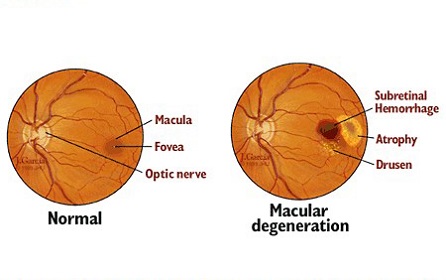New Hope for Age-Related Macular Degeneration: Vitamin D and Sulforaphane's Synergistic Effects
Nikhil Prasad Fact checked by:Thailand Medical News Team Jun 12, 2024 1 year, 5 months, 4 weeks, 22 hours, 50 minutes ago
Ophthalmology Updates: Age-related macular degeneration (AMD) is a leading cause of irreversible central blindness among the elderly in developed countries. Affecting the macula, the region of the retina responsible for central vision, AMD's prevalence is expected to rise with increasing life expectancy. It is reported that one in eight people over 60 years old will be affected by this debilitating disease. AMD manifests in two forms: dry (atrophic) and wet (exudative), with the latter being more severe due to abnormal blood vessel development that can cause significant vision loss.
 New Hope for Age-Related Macular Degeneration: Vitamin D and Sulforaphane's Synergistic Effects
The Role of Oxidative Stress and Inflammation
New Hope for Age-Related Macular Degeneration: Vitamin D and Sulforaphane's Synergistic Effects
The Role of Oxidative Stress and Inflammation
Chronic oxidative stress and inflammation are pivotal in the pathogenesis of AMD. The retina, with its high oxygen consumption, polyunsaturated fatty acid content, and light exposure, is particularly vulnerable. As we age, oxidative damage accumulates while antioxidant defenses and repair mechanisms wane, leading to retinal dysfunction and contributing to AMD development. Oxidative stress, characterized by an imbalance between the production of reactive oxygen species (ROS) and the body’s ability to detoxify these harmful byproducts, plays a crucial role in initiating and perpetuating inflammation in AMD. This vicious cycle of oxidative stress and inflammation damages the retinal pigment epithelium (RPE) cells, contributing to the disease's progression.
The Promise of Vitamin D and Sulforaphane
Recent research from the University of Torino-Italy and the University of Messina in Italy that is covered in this
Ophthalmology Updates news report, has shed light on the potential of vitamin D (VD) and sulforaphane (SF) in combating AMD. These compounds have demonstrated a synergistic effect in reducing oxidative stress, inflammation, and vascular endothelial growth factor (VEGF) secretion, which is crucial in wet AMD progression. Vitamin D, known for its role in calcium homeostasis and bone health, also exhibits anti-inflammatory and antioxidant properties. Sulforaphane, a compound derived from cruciferous vegetables like broccoli, is renowned for its potent antioxidant and anti-inflammatory effects.
Study Insights: Mechanisms and Outcomes
Researchers treated the ARPE-19 retinal epithelial cell line with transforming growth factor-beta (TGF-β) to simulate an inflamed retinal environment. TGF-β is a cytokine known to induce oxidative stress and inflammation, making it an ideal model for studying AMD pathogenesis. They then administered VD and SF, individually and in combination, observing significant reductions in ROS levels and pro-inflammatory cytokines (IL-6 and IL-8). Mitochondrial respiration, a source of ROS, was also stabilized, preventing TGF-β-induced overactivity.
The study found that VD and SF reduced the basal production of ROS and were effective in mitigating ROS production triggered by TGF-β. Moreover, the combine
d treatment of VD and SF not only enhanced these effects but also improved the integrity of epithelial junctions, crucial for maintaining retinal structure and function. The expression of tight junction proteins such as Zonula Occludens-1 (ZO-1) and Claudin-4, which are vital for epithelial barrier integrity, was restored. The study also demonstrated that the combination of VD and SF significantly reduced VEGF secretion, a key factor in the neovascularization process associated with wet AMD.
Interestingly, all the beneficial effects observed were potentiated when VD and SF were used together, highlighting their synergistic potential. The study revealed that these effects were mediated through the ERK 1/2 signaling pathway, independent of VD receptor expression.
Clinical Implications: A New Therapeutic Avenue
The findings suggest that VD and SF could be integrated into AMD treatment regimens, potentially enhancing the efficacy of existing therapies, especially in reducing inflammation and oxidative stress. Currently, anti-VEGF treatments are the mainstay for wet AMD, but they do not address the underlying inflammatory environment. Anti-VEGF therapies, while effective in reducing abnormal blood vessel growth and leakage, often require frequent intravitreal injections, which can be burdensome for patients and healthcare systems. Moreover, these treatments do not tackle the root causes of oxidative stress and inflammation, which continue to drive disease progression.
Looking Ahead: Future Research and Applications
While the in vitro results are promising, clinical trials are necessary to validate these findings in vivo. The potential to reduce the frequency of invasive anti-VEGF injections and improve patient quality of life makes this research particularly exciting. Further exploration into the molecular mechanisms of VD and SF could unlock new therapeutic targets for AMD and other inflammatory diseases. Future studies could also explore the optimal dosing and delivery methods for these compounds, ensuring maximum efficacy and patient compliance.
Conclusion: Towards Better AMD Management
Vitamin D and sulforaphane present a compelling case for a combined therapeutic approach to AMD. By mitigating oxidative stress and inflammation, these compounds could significantly improve outcomes for patients suffering from this debilitating condition. As research progresses, the hope is to develop more effective, holistic treatments that address both the symptoms and underlying causes of AMD. This could lead to improved vision preservation, enhanced quality of life, and reduced healthcare burdens associated with frequent treatments.
The study findings were published in the peer reviewed International Journal of Molecular Sciences.
https://www.mdpi.com/1422-0067/25/12/6404
For the latest
Ophthalmology Updates, keep on logging to Thailand Medical News.
Read Also:
https://www.thailandmedical.news/news/microrna-let-7f-identified-as-a-key-player-in-dry-age-related-macular-degeneration
https://www.thailandmedical.news/news/breaking-covid-19-news-sars-cov-2-causes-macular-degeneration-by-promoting-rpe-cell-senescence-via-the-ros-p53-p21-pathway
https://www.thailandmedical.news/news/age-related-macular-degeneration-linked-to-bad-western-diets
